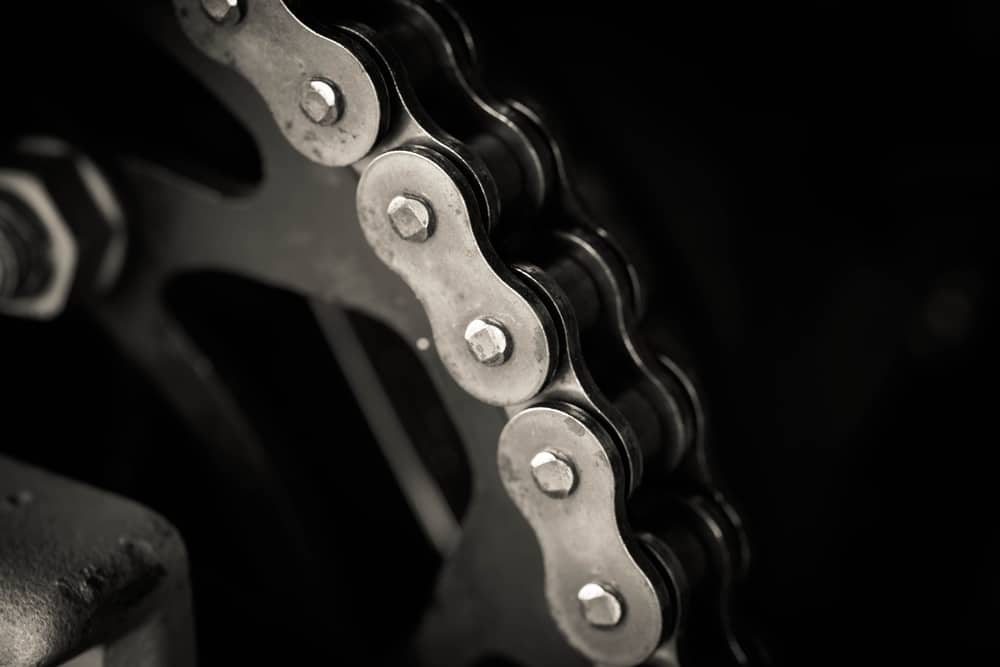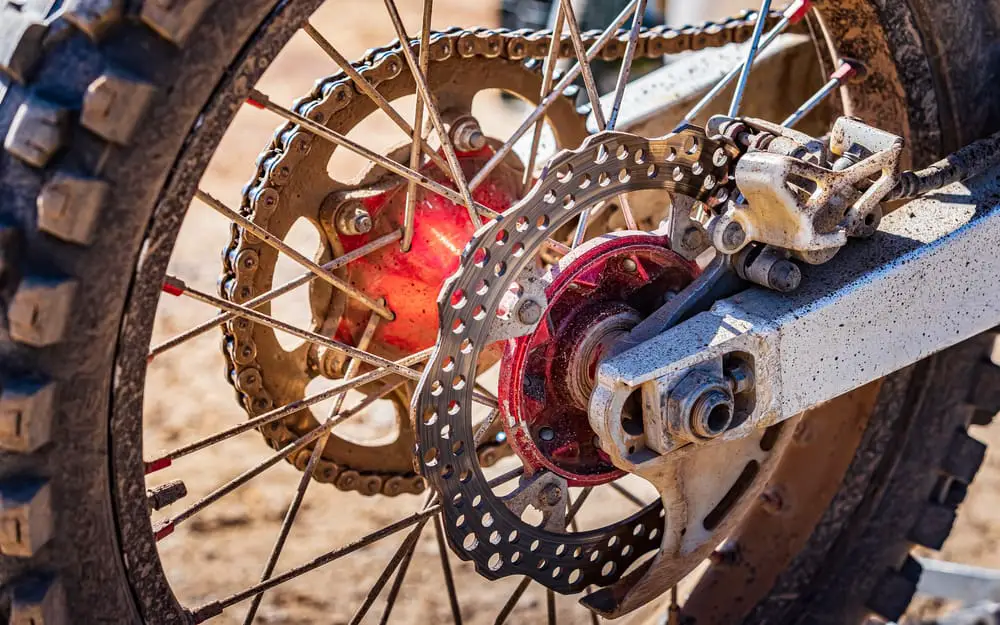
If you have ever driven a dirt bike, you probably have felt that newer chains often feel and look a little bit tighter than chains that have had a couple of miles behind them. You might have wondered why this is but not have gotten a clear answer. Some people say that chains do not (technically) stretch, whereas others say they do. So, do the chains of dirt bikes – or any motorcycle for that matter – stretch?
The chains of dirt bikes stretch in two ways. The first way is that chains expand and contract elastically on a microscopic level as a load is applied to them. Secondly, they also elongate in length due to wearing and tearing, which allows the links to be pulled further away from one another.
Chains do stretch, but what are the causes for these two different manners in which they stretch? People also tend to disagree on fundamental reasons why chains elongate; what are the misconceptions, and what is the truth behind the stretching of chains? And, how do you maintain your chains so that they keep their original shape as long as possible? All of this we explore below.
Do Dirt Bike Chains Stretch?
When it comes to the stretching of the chains of your dirt bike, we have to carefully distinguish what we mean by ‘stretching’. So, to answer the question on whether or not dirt bike chains ‘stretch’, we will discuss various opinions and some of the misconceptions of dirt bike chains and if they stretch or not.
Misconceptions About Dirt Bike Chains Stretching
First, we must take note of all the parts that form the chain. You have:
- Inner links.
- Outer links.
- Rollers.
- Pins.
For the chain of a dirt bike to stretch, there must be an elongation of one or more of these parts.
Some correctly identify that the power produced by a motorcycle of any kind, let alone a dirt bike, is not capable of overcoming the ultimate tensile strength of the chains on your motorcycle. The ultimate tensile strength of the chains found on your motorcycle starts anything from 4000 foot-pounds and upwards.
The stronger motorcycles you will find can, roughly speaking, produce 175 foot-pounds, which is not nearly close enough to reach the ultimate tensile strength of the chain of your bike. It follows that the torque produced by dirt bikes is significantly less than that of the strong motorcycles and will also not be able to overcome the ultimate tensile strength of the chain.
That being said, they – incorrectly – think that this means that the bike is not capable of stretching the chains of the bike by any means whatsoever. This is not correct because you do not have to overcome the ultimate tensile strength of a material in order to stretch it.
Furthermore, another misconception is that you have to stretch something like an elastic band before they elongate, which is not true. It is not required that something stretch elastically for it to ‘stretch’. Most consider something to stretch if an object elongates in any form.
Finally, some believe that if there is an explanation as to why the chains on any motorcycle (including dirt bikes) elongate, it is because that if dirt enters between the roller and the pin, it causes wear on the parts that make up the chain. If there is enough wear, then the chain will elongate.
Take the pins, for example: once the pins thin out, they have more room to move within the inner roller of the inner link. If the pins have more maneuverability in the inner roller, then the outside link can move more freely in the inner roller and be pulled further apart from the inner roller, giving it the impression of being a longer chain.
The misconception here, however, is that the cause of the wear and tear is assigned to the dirt.
What Really Happens When Dirt Bike Chains Stretching
When it comes to the stretching of the chains, we must define what we mean by stretching: does it mean that something stretches like a rubber band, or does it simply require that the object must, in some fashion, be longer than what it was previously?
Regardless of what your answer is to the question above, dirt bike chains do experience both of these forms of ‘stretches’ – one form more than the other.
With regards to elongating in a non-elastic sense, the individual parts of the chain do not expand like a rubber band. Nevertheless, the chain still elongates, which, according to some, still means that the chain stretches. So how does it stretch?
Your motorcycle works with a front and a rear sprocket. Your front and rear sprocket pull the chain over the teeth of each socket, and torque gets transferred from one sprocket to the other.
During this time, your chain is put under tension as the teeth of the front sprocket try to pull the chain over the front sprocket, and the teeth at the bottom of your rear sprocket are busy pulling the chain over the back sprocket. This tension that is applied to the chain is where the wearing and tearing happens.

As your chain is subjected to a load of force that creates tension upon it, the holes of the inner links become larger and larger with time. This is because the force pulls the pins of the outer links against the rollers of the inner links as the chain is being pulled. The more the pins push and rub against the rollers, the larger the holes become due to friction that causes wear.
Additionally, the rolling motion of the chain from the larger rear sprocket over the back sprocket also causes wearing. That is because the rolling of the chain over the smaller sprocket causes a sharper bend for the chain, which causes the pins to exert greater friction on the inner holes that lead to more wearing.
So, that is how the non-elastic stretching of a chain works. The wear and tear inside the inner holes of the inner links cause the links to be able to separate further from one another with time. That is why if you hold two chains next to one another – the one new and the other one used – you will see the used one looks longer, despite having the same number of links and all of the links being the same size.
With regards to the elastic stretching of chains, it is not true that chains are incapable of being stretched by a motorcycle. It is true that the motorcycle cannot break the chains based on the chain’s (ultimate) tensile strength, but that is not what is required to bend or stretch something.
Up until its yield point, materials have a range of strain it can take where it will deform elastically. This means the material under consideration will deform, but due to its elasticity, it will simply revert back to its original form.
With this information in mind, it is definitely possible to stretch a chain like a rubber band while it is being stretched in its elastic deformation range. For chains, some state that the amount of force you can apply is between 1/6th to 1/5th of the chain’s ultimate tensile strength before you start forcing the chain to tip past its yield point.
Accordingly, while in this range, your chain will slightly stretch on microscopic levels which are not visible to the naked eye, but it stretches all the same.
The Take-Away
Yes, motorcycle chains do stretch. They stretch in the conventional sense we think of how rubber bands stretch, but this happens on a microscopic level, and the chain retakes its original form once the load is taken off from it.
Chains also stretch in the sense that they elongate without the individual components of the chain stretching. It is simple wearing and tearing that causes the pins to make the holes of the inner links bigger. This allows your links to be pulled further apart than what they could normally, which makes it look as if your entire chain is longer.
How Do You Maintain The Chain Of Your Dirt Bike?
Below are things you can do to keep your chain maintained, which will decrease the wear it experiences and slow down its ‘stretching’ process:
- Make sure to clean your chain on a regular basis. Dirt is not the cause of your chain wearing and tearing, but it does not help decrease the friction between your pins or rollers.
- Inspect your chain on a regular basis. The more you inspect your chains, the better you will be able to determine if the inner rollers are damaged and starting to wear – giving your chain the stretched appearance.
- Use lubrication as much as possible. If the right amount of lubricant is applied to the chain, the pins will not push and rub against the inner rollers as often, and it will extend the life of your chain. This will also keep your chain from stretching as much as possible.
Conclusion
Unfortunately, yes, chains do stretch.
The good news is that not all forms of stretching is bad: if your chain expands and contracts like an elastic band, it will be on microscopic levels that are not even visible to the human eye.
On the other hand, wear and tear will, eventually, cause your chain’s links to be capable of being pulled further from one another than they could originally. If all of the links in your chain are capable of doing so, it will result in you having one longer chain, despite its links being the same size.
Luckily, we now know of a couple of ways to keep our chains in better shape for longer!
References
https://www.youtube.com/watch?v=KVDUktSGOPs
https://www.youtube.com/watch?v=Z_MGm4dy-8w
https://www.revzilla.com/common-tread/how-to-read-a-motorcycle-spec-sheet
https://dirttricks.com/measuring-chain-wear/
https://motorgearexpert.com/do-new-motorcycle-chains-stretch/


